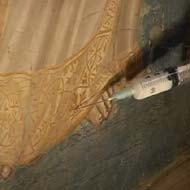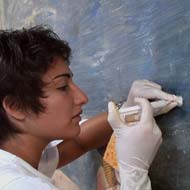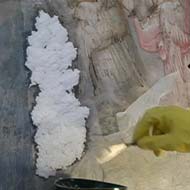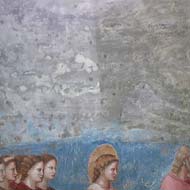 |
 |
Cleaning |
Removal of substances from the painted surface.
Such substances include solid or loose matter deposited over time (atmospheric
dust) or applied for conservation reasons (to "fix" the paint
film) or for aesthetic reasons ("neutral" tinting of the plaster
or stucco) and which have subsequently decayed.
 |
 |
 |
Prior to cleaning operations, it
is important to fix and consolidate the layers of paint (photo on
left) and the preparatory surface (photo at centre); this operation
is necessary to avoid losing material during the subsequent phases.
The illustration shows deep-seated consolidation, carried out with
injections of pre-mixed mortar in order to overcome problems of adhesion
in the plaster and the "arriccio".
Wherever possible, before the actual cleaning operation, the area
should be gently treated with distilled water, using a soft sponge
and tissue paper, to remove surface dirt. |
 |
 |
 |
| After the area has been consolidated
- the surface is cleaned with a pad made of paper pulp moistened with
distilled water, placing a layer of tissue paper between it and the
painted surface. This step is recommended for the parts painted "a
secco", which are particularly delicate. The final step is to
complete the cleaning process with a soft dry pad. The last photo
shows part of the scene depicting the Wedding Procession, before and
after being cleaned. |
 |
|
|
 |
|












